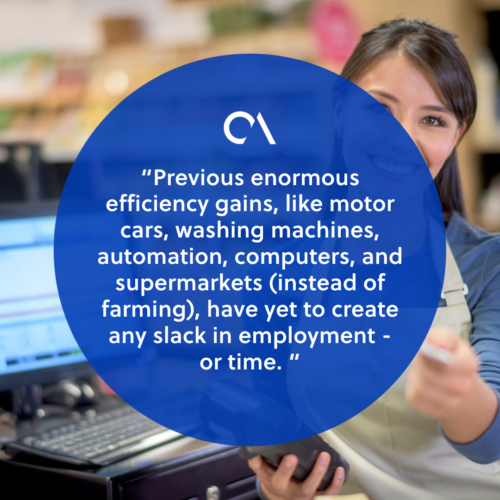Welcome back to Gone Global! There’s lots of ‘future-of-worl’ goings-on this week, including work surveillance, AI hiring, fake work accusations, the metaverse – and did I mention AI? Let’s get started!
The global employment miracle
There’s a lot of talk about AI taking over the world. And certainly, many suggest it will mortally wound the outsourcing industry’s high repetition call centers.
Thankfully, no one knows the future, and ‘expert predictions’ are notoriously wrong.
We are in the early stages of narrow artificial intelligence based on ‘Large Language Model’ technology, and it will dramatically change how some jobs are done. But will it mean the end of employment and life as we know it? Not likely.
Setting fears aside, let’s explore a framework for analyzing their impact.
Still no slack
Previous enormous efficiency gains, like motor cars, washing machines, automation, computers, and supermarkets (instead of farming), have yet to create any slack in employment – or time.
These gains have saved humanity countless hours of work, yet the population is still fully employed. For example, 30% of the population previously worked in agriculture to ensure enough food to feed the world. With technological advances, only 2.5% of US people work in agriculture today. Instead of under-employment, the economy is fully engaged and doing things other than farming.
The result is that more products are created (abundance), providing more choice and engagement. With the help of technology, products, and services are provided for increasingly less cost (TVs for $100, and Netflix for $8).
Endless upskilling
Creativity is infinite, everything can be endlessly improved, and people can endlessly upskill.
AI will assist in upskilling and doing things better, resulting in a never-ending pursuit of improvement, iteration, and evolution of products, services, and people.
Unless you believe that we are doing everything as well as we can, we have a lot of work ahead of us.
Mo money, mo problems
New solutions create a set of new problems. As new products and services are invented, a new wave of second-order issues will occur. Before Uber, there was no need for Uber customer service. As soon as Uber launched, there was suddenly a need for Uber to service customer complaints for errors and disputes and complications. This will never go away.
New, increasingly complex problems will arise as new solutions are born, creating new work to be done.
Edge cases and interplay
Structured repeatable solutions are easy to automate and optimize. But the new edge cases and the interplay of things create the work. For example, 1000 refunds are easy to process, but identifying the problem and coordinating with the CS, marketing, and finance departments, clients, and banks all require an awkward novel interplay that takes work to automate.
Dwindling population
The global population is dwindling. Most developed countries have a replacement rate of just 1.3-1.5 per couple. This means the population is fast shrinking, and there will be far fewer people capable of working to support the growing numbers of retired and elderly.
Increased efficiency through technology is essential to ensure that we can cope with the dwindling population. Essentially, we need to redundiate workers through optimization – otherwise, we will go backward.
Slow adoption
Electricity was invented in 1700. Yet it wasn’t until about 1890 that factories were using the technology. However, it took until 1920 for widespread adoption across all factories. Despite being a no-brainer, things are generally slowly adopted. Old habits die hard.
The question for your business
Is hiring locally slowing you down?


 Independent
Independent





















